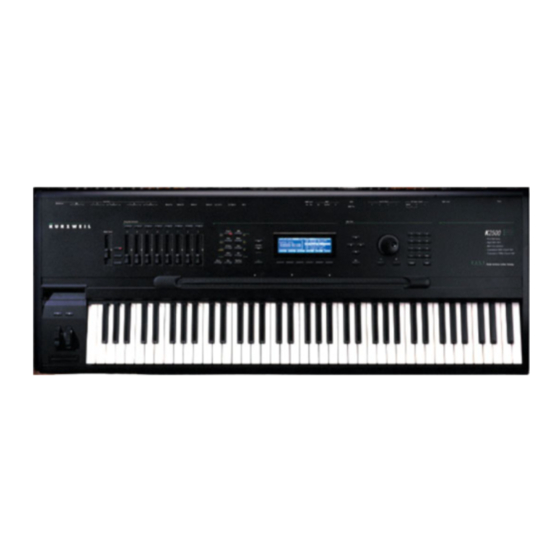Advertisement
Chapter 18
Audio Outputs
Audio Configurations
The K2500 features ten audio jacks, enabling you to route the K2500's sounds through its own
internal effects processor, through an external effects device, or through combinations of the
two. Of course the K2500's effects processor can be bypassed as well.
On the rear panel are a pair of stereo mix jacks (MIX L and R), and eight additional jacks—
A (L and R), B (L and R), C (L and R), and D (L and R). These can be configured as four stereo
pairs or as eight separate outputs. Your audio configuration is determined by two factors. The
"hardware" side has to do with which jacks you use and what kind of cables you connect to
them. The "software" side depends on the settings you make for parameters on the OUTPUT
page in the Program Editor, and on the Master mode page.
The simplest configuration would involve connecting the left and right MIX outputs directly to
a mixing board or keyboard amplifier. If you're using only one input to your sound system
from the K2500, use the left MIX output for a mono signal. We'll assume for now that you're
using only the MIX outputs. The use of the separate outputs is discussed later in this chapter.
Note: we recommend that you make the cable connection to the K2500 (or any instrument)
after you've made your other audio connections, since this reduces the chance of creating static
electricity that can cause an audible "pop" (and, in extreme cases, cause equipment damage).
Using the MIX Outputs
If you plan to use the K2500's global effects processor to add dimension to your sounds, you'll
need to use the MIX outputs. The audio output to the separate outputs is always dry—that is,
the audio signal is sent to the separate outputs without passing through the global effects
processor. The MIX outputs and the headphone jack are the only jacks where the signal will
appear with effects.
The signal is routed using the OUTPUT page in the Program Editor. While in Program mode,
press the EDIT button, then press one of the <more> soft buttons until you see "OUTPUT" on
the display's bottom line. Press the corresponding soft button, and the OUTPUT page will
appear. Set the value of the Pair parameter to A(FX) if you want the current layer's sound to be
routed through the effects processor before appearing at the MIX outputs.
A value of A(FX) means two things: first, the layer's sound will appear with effects at the MIX
outputs, and second, that the layer's sound will appear without effects at the Group A outputs if
standard audio cables are inserted into the Group A output jacks. Set the value of the Pair
parameter to B(DRY), C(DRY), or D(DRY) if you want the layer's sound to appear without
effects at the MIX outputs. It will also appear at the Group B, C, or D outputs if standard audio
cables are inserted into the respective output jacks. Connecting audio cables to the separate
outputs will remove part or all of the signal from the MIX outputs. Be sure to set the output pair
for every layer in the program; each layer can be routed independently (use the CHAN/Bank
buttons to scroll through the layers). You'll also want to set the pan position for each layer
while you're on the OUTPUT page. Depending on the program you're working with, you'll
have several different options for panning. See "The OUTPUT Page" in Chapter 6 for an
explanation of these options. Also see "PANNER" in Chapter 14 to learn how to gain even more
control over a layer's pan position.
Audio Outputs
Using the MIX Outputs
18-1
Advertisement
Table of Contents

Subscribe to Our Youtube Channel
Summary of Contents for Kurzweil K2500 - PERFORMANCE GUIDE REV F PART NUMBER 910251 CHAP 18
- Page 1 Audio Outputs Using the MIX Outputs Chapter 18 Audio Outputs Audio Configurations The K2500 features ten audio jacks, enabling you to route the K2500’s sounds through its own internal effects processor, through an external effects device, or through combinations of the two.
- Page 2 Audio Outputs Using the Separate Outputs Using the Separate Outputs The K2500’s eight separate outputs are arranged in four pairs, A, B, C, and D. These are mono output jacks, and you’ll normally plug a standard audio cable into one or more of them. Depending on the OUTPUT page settings you use for a given program’s layers, they can function as four stereo output pairs, or as eight separate outputs.
- Page 3 Audio Outputs Using the Separate Outputs Hardware Audio Switching It’s important that you understand the effect on the MIX outputs when you use the separate outputs. When you connect a standard audio cable to any of the separate outputs, every sound (or part of a sound) that’s assigned to the output you connect will be removed from the MIX outputs.
- Page 4 Audio Outputs Output Groups and MIDI Channels and set the Out A->Mix parameter to mono, and the Out A->FX parameter to L Only. This will send programs routed to Output Group A to the MIX outputs without going through the K2500’s effects processor, but will still send the signal to both the left and right MIX outputs.

















Need help?
Do you have a question about the K2500 - PERFORMANCE GUIDE REV F PART NUMBER 910251 CHAP 18 and is the answer not in the manual?
Questions and answers